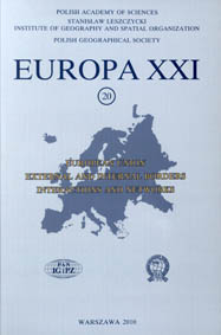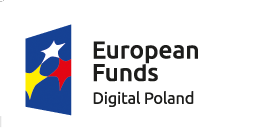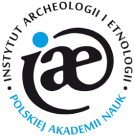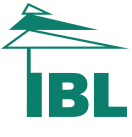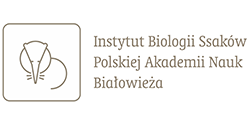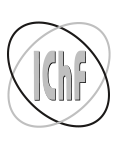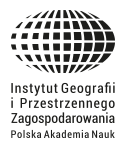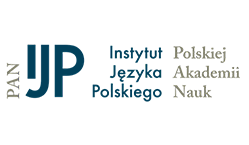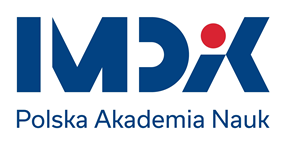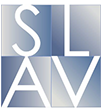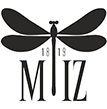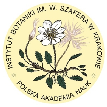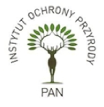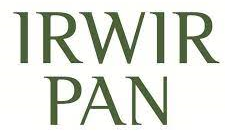- Search in all Repository
- Literature and maps
- Archeology
- Mills database
- Natural sciences
Advanced search
Advanced search
Advanced search
Advanced search
Advanced search

Object
Title: Relationships between actors of transborder co-operation Polish-German borderland case study
Subtitle:
Publisher:
Place of publishing:
Description:
Degree discipline :
cross-border cooperation ; transborder connections ; borderland region
Type of object:
Abstract:
The study allowed to determine the level of development of transborder co-operation connections, thematic scope and the strength of connections between the partners in the Polish-German border areas. The analysis of actors helped identify institutional settings on both sides of the border (levels of co-operation according to the level of territorial unit and similarity between actors in terms of their formal-legal status). The analysis also covered the spatial aspect of the existing network of connections. The study takes into consideration mutual relationships between the analyzed features. The analysis revealed similarities between institutional network of the co-operating authors and a relatively limited strength of connections. Moreover, the study showed that the type of actors, the strength of connections and thematic scope of jointly realized projects were strongly interconnected.
References:
1. Ciok, S. (2004), Pogranicze polsko-niemieckie. Problemy współpracy transgranicznej, Wydawnictwo Uniwersytetu Wrocławskiego, Wrocław.
2. Dołzbłasz, S. and Raczyk, A. (2007), New versus old cross-border cooperation programmes in the example of Polish-Czech and Polish-German border areas, Europa XXI, 16, Institute of Geography and Spatial Organization, PAS, Warszawa, 153–166.
3. Dołzbłasz, S. and Raczyk, A. (2010), Współpraca transgraniczna w Polsce po akcesji do UE, Wolters Kluwer, Warszawa.
4. Hall, P. (2008), Opportunities for democracy in cross-border regions? Lessons from the Oresund Region, Regional Studies, 42 (3), 423–435.
http://dx.doi.org/10.1080/00343400701281592 -
5. Jańczak, J. (2008), Polsko-niemieckie regiony transgraniczne i miasta transgraniczne po 2004 roku. Pomiędzy pragmatyzmem instytucjonalnym a izolacją społeczną, in: Dołzbłasz S. and Raczyk A. (eds.) Przekształcenia regionalnych struktur funkcjonalno-przestrzennych, Europa bez granic—nowa jakość przestrzeni, Rozprawy Naukowe Instytutu Geografii i Rozwoju Regionalnego Uniwersytetu Wrocławskiego, 4, Wrocław, 93–100.
6. Koschatzky, K. (2000), A River is a river—Cross-border networking between Baden and Alsace, European Planning Studies, 8 (4), 429–449.
http://dx.doi.org/10.1080/713666422 -
7. OJ L 63/21, 3.3.2001, Rozporządzenie Komisji (WE) nr 438/2001 z dnia 2 marca 2001 ustanawiające szczegółowe zasady wykonania Rozporządzenia Komisji (WE) nr 1260/1999 dotyczącego zarządzania i systemów kontroli pomocy udzielanej w ramach Funduszy Strukturalnych, Załącznik IV, p. 2, 3.
8. Strihan, A. (2008), A network-based approach to regional borders: the case of Belgium, Regional Studies, 42 (4), 539–554.
http://dx.doi.org/10.1080/00343400701541813 -
9. Szmigiel, K., Dziemianowicz, W., Dołzbłasz, S., Durability of international partnerships in transborder co-operation, project financed by Ministry of Science and Higher Education (2009–2011).
Relation:
Volume:
Start page:
End page:
Detailed Resource Type:
Format:
File size 0,9 MB ; application/pdf
Resource Identifier:
oai:rcin.org.pl:55808 ; 1429-7132 ; 10.7163/Eu21.2010.20.9
Source:
CBGiOŚ. IGiPZ PAN, call nos.: Cz.6406, Cz.6407 ; click here to follow the link
Language:
Rights:
Terms of use:
Copyright-protected material. May be used within the limits of statutory user freedoms
Digitizing institution:
Institute of Geography and Spatial Organization of the Polish Academy of Sciences
Original in:
Projects co-financed by:
European Union. European Regional Development Fund ; Programme Innovative Economy, 2010-2014, Priority Axis 2. R&D infrastructure
Access:
Object collections:
- Digital Repository of Scientific Institutes > Partners' collections > Institute of Geography and Spatial Organization PAS (IGiPZ PAN) > Publications of IGiPZ PAN and employees
- Digital Repository of Scientific Institutes > Partners' collections > Institute of Geography and Spatial Organization PAS (IGiPZ PAN) > Library > Series/Journals/Periodics
- Digital Repository of Scientific Institutes > Literature > Journals/Articles
Last modified:
Jul 26, 2023
In our library since:
Aug 13, 2015
Number of object content downloads / hits:
1022
All available object's versions:
https://rcin.org.pl./publication/75621
Show description in RDF format:
Show description in RDFa format:
Show description in OAI-PMH format:
| Edition name | Date |
|---|---|
| Dołzbłasz S., Raczyk A. - Relationships between actors of transborder co-operation Polish-German borderland case study | Jul 26, 2023 |
Objects Similar
Dołzbłasz, Sylwia
Leśniak-Johann, Małgorzata Raczyk, Andrzej
Dołzbłasz, Sylwia
Smahó, Melinda
Więckowski, Marek (1971– )

 INSTYTUT ARCHEOLOGII I ETNOLOGII POLSKIEJ AKADEMII NAUK
INSTYTUT ARCHEOLOGII I ETNOLOGII POLSKIEJ AKADEMII NAUK
 INSTYTUT BADAŃ LITERACKICH POLSKIEJ AKADEMII NAUK
INSTYTUT BADAŃ LITERACKICH POLSKIEJ AKADEMII NAUK
 INSTYTUT BADAWCZY LEŚNICTWA
INSTYTUT BADAWCZY LEŚNICTWA
 INSTYTUT BIOLOGII DOŚWIADCZALNEJ IM. MARCELEGO NENCKIEGO POLSKIEJ AKADEMII NAUK
INSTYTUT BIOLOGII DOŚWIADCZALNEJ IM. MARCELEGO NENCKIEGO POLSKIEJ AKADEMII NAUK
 INSTYTUT BIOLOGII SSAKÓW POLSKIEJ AKADEMII NAUK
INSTYTUT BIOLOGII SSAKÓW POLSKIEJ AKADEMII NAUK
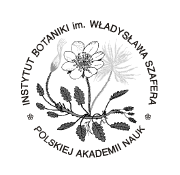 INSTYTUT CHEMII FIZYCZNEJ PAN
INSTYTUT CHEMII FIZYCZNEJ PAN
 INSTYTUT CHEMII ORGANICZNEJ PAN
INSTYTUT CHEMII ORGANICZNEJ PAN
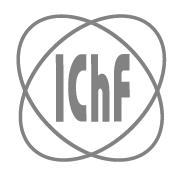 INSTYTUT FILOZOFII I SOCJOLOGII PAN
INSTYTUT FILOZOFII I SOCJOLOGII PAN
 INSTYTUT GEOGRAFII I PRZESTRZENNEGO ZAGOSPODAROWANIA PAN
INSTYTUT GEOGRAFII I PRZESTRZENNEGO ZAGOSPODAROWANIA PAN
 INSTYTUT HISTORII im. TADEUSZA MANTEUFFLA POLSKIEJ AKADEMII NAUK
INSTYTUT HISTORII im. TADEUSZA MANTEUFFLA POLSKIEJ AKADEMII NAUK
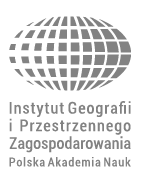 INSTYTUT JĘZYKA POLSKIEGO POLSKIEJ AKADEMII NAUK
INSTYTUT JĘZYKA POLSKIEGO POLSKIEJ AKADEMII NAUK
 INSTYTUT MATEMATYCZNY PAN
INSTYTUT MATEMATYCZNY PAN
 INSTYTUT MEDYCYNY DOŚWIADCZALNEJ I KLINICZNEJ IM.MIROSŁAWA MOSSAKOWSKIEGO POLSKIEJ AKADEMII NAUK
INSTYTUT MEDYCYNY DOŚWIADCZALNEJ I KLINICZNEJ IM.MIROSŁAWA MOSSAKOWSKIEGO POLSKIEJ AKADEMII NAUK
 INSTYTUT PODSTAWOWYCH PROBLEMÓW TECHNIKI PAN
INSTYTUT PODSTAWOWYCH PROBLEMÓW TECHNIKI PAN
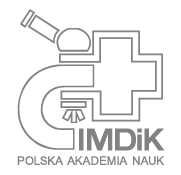 INSTYTUT SLAWISTYKI PAN
INSTYTUT SLAWISTYKI PAN
 SIEĆ BADAWCZA ŁUKASIEWICZ - INSTYTUT TECHNOLOGII MATERIAŁÓW ELEKTRONICZNYCH
SIEĆ BADAWCZA ŁUKASIEWICZ - INSTYTUT TECHNOLOGII MATERIAŁÓW ELEKTRONICZNYCH
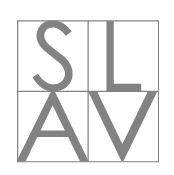 MUZEUM I INSTYTUT ZOOLOGII POLSKIEJ AKADEMII NAUK
MUZEUM I INSTYTUT ZOOLOGII POLSKIEJ AKADEMII NAUK
 INSTYTUT BADAŃ SYSTEMOWYCH PAN
INSTYTUT BADAŃ SYSTEMOWYCH PAN
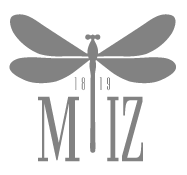 INSTYTUT BOTANIKI IM. WŁADYSŁAWA SZAFERA POLSKIEJ AKADEMII NAUK
INSTYTUT BOTANIKI IM. WŁADYSŁAWA SZAFERA POLSKIEJ AKADEMII NAUK
